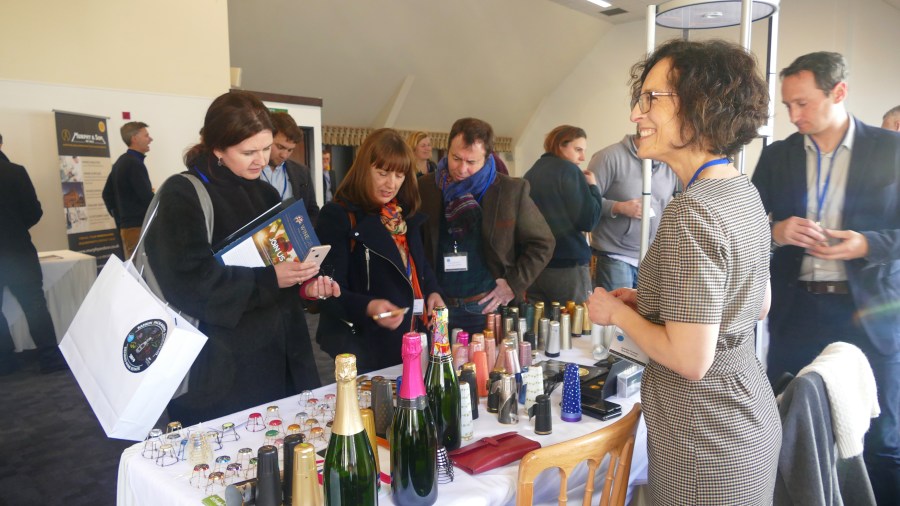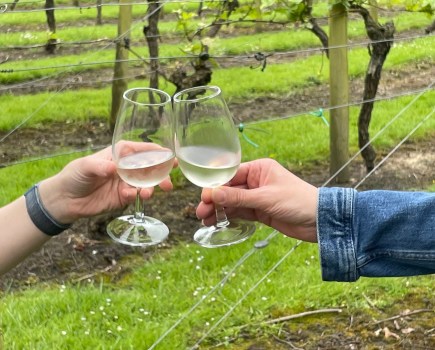Over 50 English wine producers, from as far afield as Somerset, travelled to Denbies Wine Estate in Surrey on Wednesday 13 March 2019 for Rankin Brothers and Sons’ annual packaging symposium.
Now in its second year, the event is designed to put brand owners and winemakers in front of the manufacturers developing key packaging tools to help wines achieve the right image, while increasing brand loyalty and communication with the consumer.
Showcasing the world of design and packaging, from glass bottles, to labels, corks, foils and boxes, alongside Rankins, Avery Dennison, Boxes and Packaging, the Brand Foundry, Cork Supply, Estal, Royston Labels and the Sparflex group, were all on hand to discuss how they could best support, promote and protect producers’ brands.
This year, a new exhibitor, Murphy and Son also joined the mix to provide producers with a full range of solutions in all areas of wine production, including fermentation, fining, stabilisation and filtration.
A series of trade presentations was followed by a further chance for networking, catching up with friends and browsing the latest packaging developments over a glass of Denbies’ Flint Valley.
Rankin Brothers and Sons
The independent, family owned and managed business has been supporting the beers, wines and spirits industries since 1774. Supplying the market with a range of closures and bottle decorations, Rankins provides wine producers across England and Wales with an extensive menu of choice when it comes to selecting the right corks, foils, wire hoods and capsules.
Dedicated to ensuring that the industry has access to the best raw materials, Rankins is the only UK based cork company to own and manage 4,500-acres of cork forestry in the Ribatejo region of Portugal.
“We are very proud to be able to say that we, as a business, have been growing and producing natural cork since the 1800s,” said Glyn Scriven, business development manager at Rankins, as he welcomed delegates to the afternoon symposium.
“Looking at the industry growth predictions from WineGB, by 2040 there will be 40 million bottles of English and Welsh wine being produced each year; that is no small figure. If the sector is going to grow, growers and winemakers need to ensure that the wine is produced to the highest level. But equally, if we are going to ensure success in a busy market place it is vital that producers have an effective brand and that the bottles stand out on a shelf.”
As well as helping producers to forge relationships with independent suppliers, to best serve the industry, Rankins has also developed a number of supply chain partnerships and is the UK distributor for Cork Supply and the Sparflex group, who were also exhibiting at the event.
Avery Dennison
Proving that durability and touch doesn’t have to mean a compromise on design, Avery Dennison, creators of an assortment of label materials, were showcasing its new Sensorial Collection, which includes some unusual label material options such as cherry wood and velvet.
“Today’s consumers are very tactile,” said Andrew Douglas. “People are looking for confirmation that they are making the right purchase, so they will take things off a shelf and if it feels like quality, then in their mind the wine must be good too. It always comes back to that old adage – it is the branding which sells the first bottle and the liquid inside which sells the second and third.”
The firm has also noticed an increase in wine producers using its range of clear labels, which are designed to look like embossed glass. Small companies who can’t afford, or don’t need to have 100,000 bespoke bottles produced, can simply purchase 20,000 labels and apply them to achieve the same visual appeal.
Ensuring that visual appeal is never compromised, Avery Dennison has also produced a range of waterproof labels.
“From trade shows and events, to being served in a restaurant or bar, it is likely that the wine is going to need to spend a long time in an ice bucket at some point,” said Andrew. “Producers need to be confident that their labels will look presentable throughout their lifetime and that is where we come in. As well as developing materials which can withstand water, we have also adapted an industrial material to provide an exceptionally strong synthetic label which is very difficult to tear.”
Boxes and Packaging
After working with a few local vineyards, Oxford-based Boxes and Packaging was able to gain a real insight into the UK wine industry’s packaging needs and over the years has carved a solid reputation as one of the leading corrugated cardboard box suppliers to vineyards in the South East of England.
Not only does the manufacturer have numerous box designs to choose from, including basic wine boxes which can hold various quantities, individual gift boxes, delivery packs with internal divisions which keep bottles secure in transit, e-commerce boxes which have pre-applied tape for ease of use, and packs which can hold wine glasses as well as wine, there is also a wide range of print qualities available too.
“We have the ability to create some really complex designs,” said Jonathan Lewis. “As well as the option to add varnishes and special finishes to the boxes, our digital printing capability now means that, potentially, every box could be unique and instead of being limited to having 5,000 printed we can do much smaller runs.”
Producers with unusual bottle shapes and sizes can work with the box design team to guarantee the perfect fit, and those who are passionate about sustainability will be happy to know that the typical wine box is produced from 80% recycled material.
The team at Boxes and Packaging also works closely with luxury packaging consultant Matt Swift to drive innovation in gift packaging and together they have created some really unique offerings.
“We work with producers to help them understand gifting and to connect to the end user,” said Matt Swift. “We work on the philosophy that each sale should drive another, so we look at the gifting experience and what can be done visually to enhance this and build brand loyalty with customers. There are lots of fantastic wines being produced and brand owners now need to look at how they can differentiate themselves and make the customer engage with the wine and drive additional sales.”




